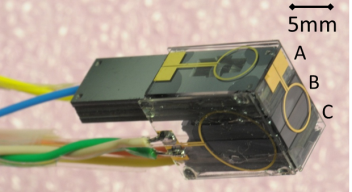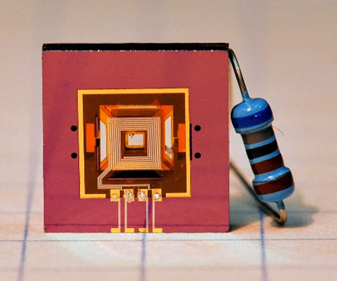Summary
We combine novel concepts of atomic physics and advanced technology of microfabrication processes to develop miniaturized atomic devices which leverage atoms’ universal quantum nature and offer high sensitivity, stability, and accuracy. We demonstrate chip-scale, high-performance atomic magnetometers that are commercialized and used for magnetic anomaly detection, nuclear magnetic resonance, and biomagnetics.
Description

Figure 1 chip-scaled atomic magnetometer assembly
Our program aims to develop sensors that can simultaneously achieve high absolute scalar accuracy and vector magnetic field measurement without the need for calibrations. An atomic magnetometer relies on the fundamental constants of nature to translate magnetic fields into a measurable Larmor frequency. The sensors are based on a heated sample of alkali atoms, which are spin-polarized with a polarized light field. Scalar atomic magnetometers have demonstrated competitive performance to the state-of-art SQUID-based magnetic sensors without the need for cryogenic cooling while vector atomic magnetometers with the capability of detecting both DC and AC magnetic fields offer advantages of accuracy and long-term stability without systematic error dependence on factors such as mechanical tolerance and alignment accuracy.

Leveraging early chip-scaled atomic clock (CSAC) concepts, we also develop microfabricated packages to reduce power consumption for space compatible geoscience and earth science applications.
Publications
[1] H. Korth, J. E. Kitching, J. W. Bonnell, B. A. Bryce, G. B. Clark, W. K. Edens, C. B. Gardner, W. Rachelson, and A. Slagle, “Flight demonstration of a miniature atomic scalar magnetometer based on a microfabricated rubidium vapor cell”, Review of Scientific Instruments 94, 035002 (2023)
[2] J. T. Robinson, E. Pohlmeyer, M. C. Gather, C. Kemere, J. E. Kitching, G. G. Malliaras, A. Marblestone, K. L. Shepard, T. Stieglitz, and C. Xie, "Developing Next-generation Brain Sensing Technologies – A Review," IEEE Sensors Journal, p. 1 (2019).
[3] J. Kitching, "Chip Scale Atomic Devices," Applied Physics Reviews, 5, p. 031302 (2018).
[4] R. Jiménez-Martinez, D.J. Kennedy, M. Rosenbluh, E.A. Donley, S. Knappe, S.J. Seltzer, H.L. Ring, V.S. Bajaj, and J. Kitching, "Optical hyperpolarization and NMR detection of 129Xe on a microfluidic chip," Nature Communications, p. 1 (2014).
[5] T. H. Sander, J. Preusser, R. Mhaskar, J. Kitching, L. Trahms, and S. Knappe, "Magnetoencephalography with a Chip-Scale Atomic Magnetometer," Biomedical Optics Express, 3, p. 981 (2012)
[6] R. Jimenez-Martinez, W. C. Griffith, S. Knappe, J. Kitching, and M. Prouty, "High Bandwidth Optical Magnetometer," Journal of the Optical Society of America B, 29, p. 3395 (2012)
[7] W. C. Griffith, S. Knappe, and J. Kitching, "Femtotesla atomic magnetometry in a microfabricated vapor cell," Optics Express, 18, p. 27167 (2010)
[8] M. P. Ledbetter, I. M. Savukov, D. Budker, V. Shah, S. Knappe, J. Kitching, D. J. Michalak, S. Xu, and A. Pines, "Zero-field remote detection of NMR with a microfabricated atomic magnetometer," Proceedings of the National Academy of Sciences, 105, p. 2286 (2008)
[9] P. D. D. Schwindt, S. Knappe, V. Shah, L. Hollberg, J. Kitching, L. A. Liew, and J. Moreland, "Chip-scale atomic magnetometer," Applied Physics Letters, 85, p. 6409 (2004)

